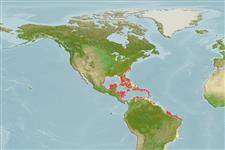>
Carangiformes (Jacks) >
Carangidae (Jacks and pompanos) > Caranginae
Etymology: Caranx: French, carangue, the name of a Caribbean fish; 1836 (Ref. 45335).
More on author: Bloch.
Environment: milieu / climate zone / depth range / distribution range
Ecologia
marinhas associadas(os) a recifes; oceanódromo (Ref. 51243); intervalo de profundidade 0 - 35 m (Ref. 40849), usually 0 - 22 m (Ref. 9710). Subtropical; 35°N - 33°N, 100°W - 33°W
Western Atlantic: New Jersey (USA), Bermuda, and Gulf of Mexico to southern Brazil; throughout the Caribbean Sea (Ref. 9626). Most common in the West Indies (Ref. 26938).
Length at first maturity / Tamanho / Peso / Idade
Maturity: Lm 31.0, range 26 - ? cm
Max length : 73.0 cm FL macho/indeterminado; (Ref. 6937); common length : 50.0 cm TL macho/indeterminado; (Ref. 5217); peso máx. Publicado: 8.2 kg (Ref. 3277)
Descrição breve
Chaves de identificação | Morfologia | Morfometria
Espinhos dorsais (total) : 8 - 9; Raios dorsais moles (total) : 26 - 30; Espinhos anais: 2 - 3; Raios anais moles: 23 - 26.
Common in clear insular areas or in coral reefs off mainland coasts (Ref. 5217). Juveniles frequent areas with algae (e.g. Sargassum) (Ref. 26235). Usually in schools which may be spawning groups; occasionally solitary. Feeds on fishes, shrimps and other invertebrates. Marketed fresh (Ref. 56217). Easily approached (Ref. 9710). Large individuals have caused ciguatera when eaten (Ref. 13442).
Berry, F.H. and W.F. Smith-Vaniz, 1978. Carangidae. In W. Fischer (ed.) FAO species identification sheets for fishery purposes. West Atlantic (Fishing Area 31). volume 1. FAO, Rome. [var. pag.]. (Ref. 3277)
Categoria na Lista Vermelha da IUCN (Ref. 130435)
Ameaça para o homem
Reports of ciguatera poisoning (Ref. 30302)
Utilização humana
Pescarias: espécies comerciais; peixe desportivo: sim
Ferramentas
Relatórios especiais
Descarregue XML
Fontes da internet
Estimates based on models
Preferred temperature (Ref.
123201): 23.2 - 28, mean 26.8 °C (based on 420 cells).
Phylogenetic diversity index (Ref.
82804): PD
50 = 0.5000 [Uniqueness, from 0.5 = low to 2.0 = high].
Bayesian length-weight: a=0.01585 (0.01287 - 0.01951), b=2.94 (2.91 - 2.97), in cm total length, based on LWR estimates for this species (Ref.
93245).
Nível Trófico (Ref.
69278): 4.3 ±0.1 se; based on diet studies.
Generation time: 7.7 ( na - na) years. Estimated as median ln(3)/K based on 1
growth studies.
Resiliência (Ref.
120179): Médio, tempo mínimo de duplicação da população 1,4 - 4,4 anos (K=0.14-0.24; tm=3; Fec=800,000).
Fishing Vulnerability (Ref.
59153): High vulnerability (57 of 100).
Climate Vulnerability (Ref.
125649): Very high vulnerability (84 of 100).
Nutrients (Ref.
124155): Calcium = 13.4 [5.4, 24.9] mg/100g; Iron = 0.347 [0.166, 0.748] mg/100g; Protein = 20.6 [18.2, 23.0] %; Omega3 = 0.17 [0.09, 0.32] g/100g; Selenium = 16.9 [6.9, 41.2] μg/100g; VitaminA = 62.4 [20.7, 184.8] μg/100g; Zinc = 0.341 [0.224, 0.543] mg/100g (wet weight);
